
Point Clare Cemetery War Graves
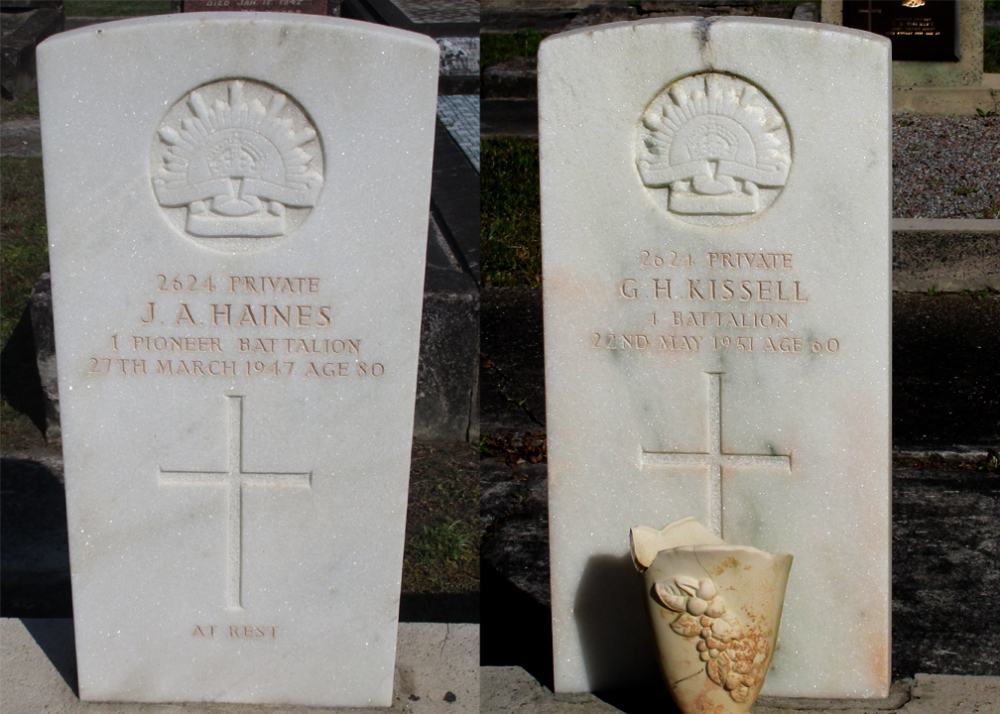
Point Clare Cemetery War Graves
Until the mid 1950’s all returning servicemen and women could if requested by the family, receive the honour of a beautiful white marble or brown granite headstone courtesy of the Commonwealth War Graves Commission. There are in total 23 Official War Grave Headstones that are the traditional headstones, maintained by the Commonwealth War Graves Commission (They maintain, weed and clean them annually). After sometime in the 1950’s they ceased to issue the stone headstone and reverted to a brass plaque to commemorate the War dead.
The stone headstones are made of the white marble from South Ulam in Queensland and is used for Australian war graves throughout the world. South Ulam marble is a metamorphic rock that is created from limestone after it has been subjected to extreme heat and pressure. The size of the calcite crystals in South Ulam marble has been determined by the amount of metamorphism it had been exposed to.
Marble that has been exposed to higher levels of heat and pressure generally have larger calcite crystals than it would have otherwise. These over sized crystals is what makes these war graves sparkle the way that they do.
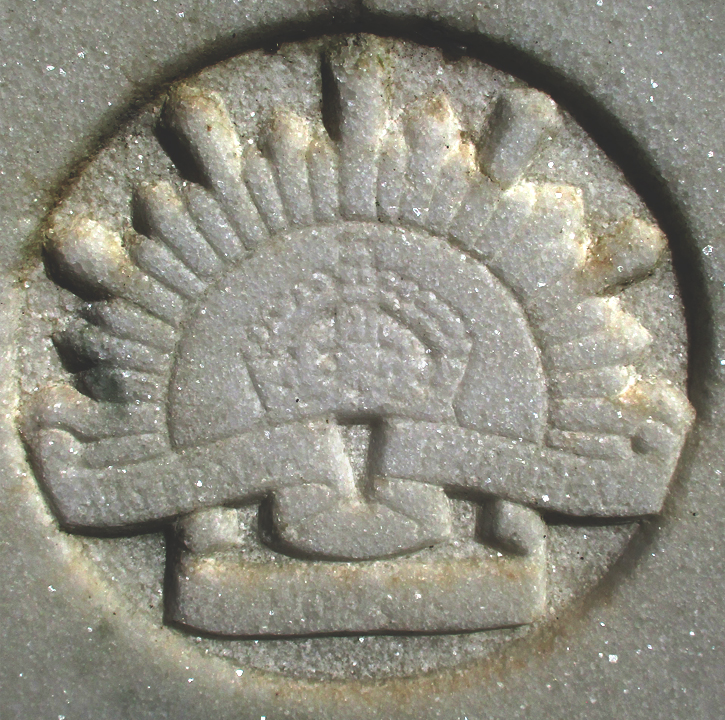
There are also brown stone war graves at Point Clare Cemetery, they are made from a stone called Trachyte, which is a fine grained form of granite from the Southern Highlands near Bowral NSW.
The Commonwealth War Graves Commission assures me that they do not make mistakes when it comes to the War Graves at this or any other cemetery and that their records are a true and correct reflection of what is at ground level at the site. I beg to differ. There are mistakes as to the number of stones/what they are made of, service numbers of the soldiers and the details on the stones (like the age when the soldier died).
For the number of mistakes in this cemetery alone, Point Clare is by no means one of the largest cemeteries in the country, one can only imagine how many other mistakes there are on stones in other cemeteries around Australia.
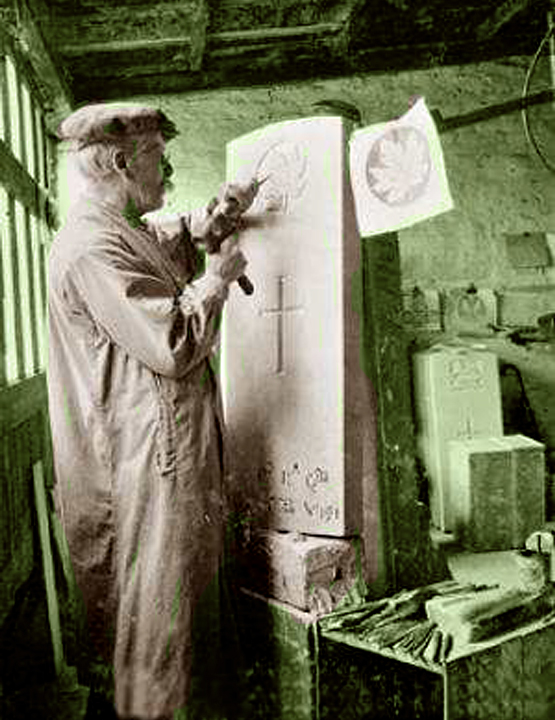
The Commonwealth War Graves Commission’s records reflect that there are seven white Marble stones and that the rest are of the brown trachyte granite. As you glance around Point Clare Cemetery you will see several of the white Ulam Marble war grave stones and it will not take you long to count more than seven of the white ones. My estimate is there is thirteen of the white marble stones all up. But there is an even more curious mistake amongst these war graves but I will get to that a bit later. Including one that is not on their official list (P. J. Wells). It is to our benefit that there are more of the white marble stone than the brown trachyte one as the white stones just sparkle and gleam back at you.
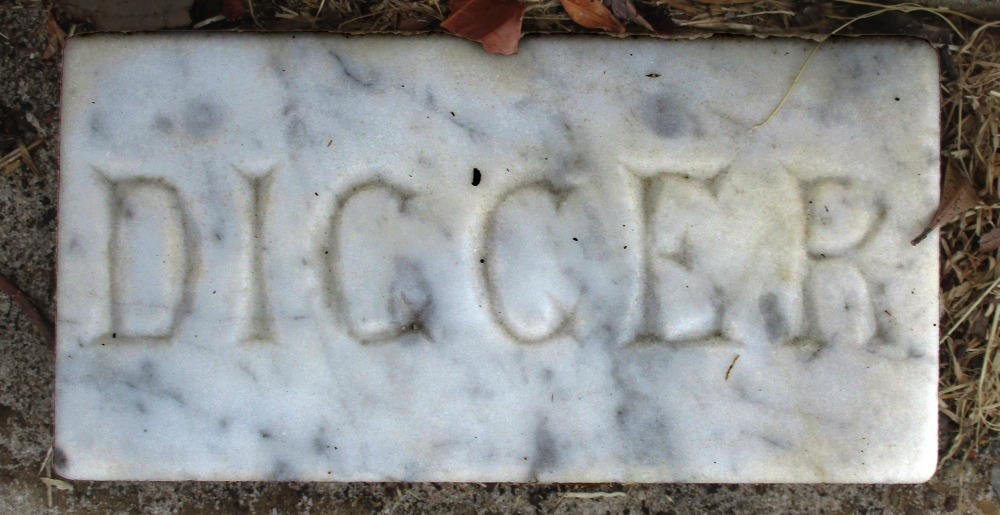
Not all of the people in these graves made a name for themselves in the local paper, which is my primary source of information for all of this cemetery some of the following is information gleaned about these some returned soldiers from either the local paper or their war service records. I will in time add to this list and attempt to find information about all 23 of these returned service men. There is no particular reasoning as to why someone gets a white or a brown headstone, but there is an effort to conserve some of the white marble as it is a finite resource reserved for the Commonwealth War Graves in other countries.
There is only one stone that was erected during the wars (either WW1 or WW2) a brown trachyte stone. This is the grave of Reginald Thompson, a 16 year old Naval cadet who went AWOL and committed suicide in the bush up at Somesby in the summer of 1919.
Reginald Thomas enlisted 19 August, 1918, His service record is only 2 pages long, he had “Straw” coloured hair fair complexion and blue eyes. He was 5 foot 4 inches tall. He has a scar on his right third finger on the inside. He died on or about 14 January, 1919. The navy approved an expenditure of £10 in respect for his funeral and that money was forwarded to the Next of Kin. That is the extent of his service record.
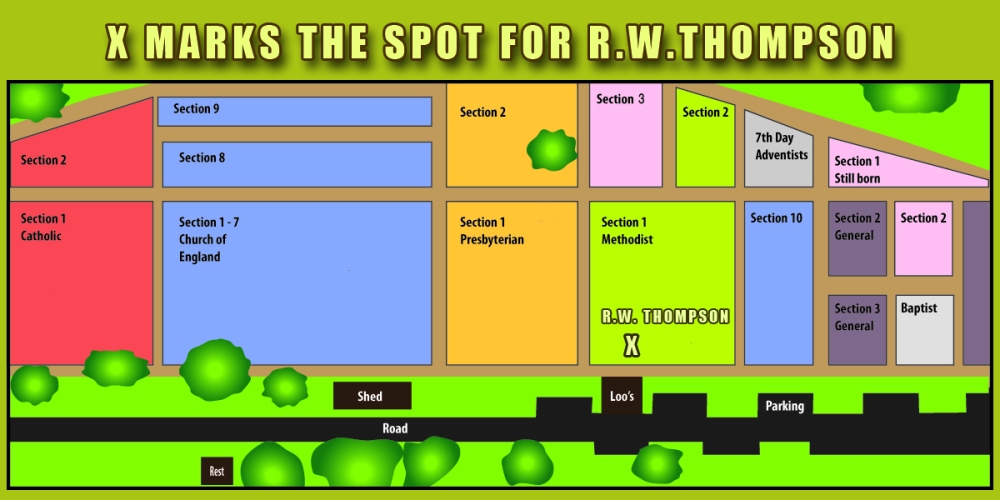
Reginald Thompson Aged 16 14/1/1919
Methodist Section 1 Row 1 Grave 9
Service number 6793 Brown Trachyte Military Stone
20th February 1919
Sad Suicide Case.
Naval Trainee Strangles Himself.
About 6 p m. on Thursday last Ernest Gambling accidentally came across a body suspended from a dry tree limb at Somesby about 50 yards off the main road. His attention was drawn to the spot by a horse rug which was also hanging from the tree.
He immediately rang up the police, and Sergeant Morris proceeded to the spot. The body was dressed in a striped cotton shirt, dark tweed coat and black sailor trousers. A pair of heavy boots with cashmere socks was lying close by.
There was also a bundle of sailor clothes near the spot bearing the names ‘ H. M. A..S. Tingara ” and R. W. Thompson.
The body, which was badly decomposed, was suspended from the tree limb by a cord attached to the boy’s neck. It was not sufficiently long to permit of any drop, and the lower portion of the body was practically resting on the ground.
In the breast of the coat pocket the Sergeant found a leather purse containing 17s Id.
Subsequently the body was identified by Mr. Robert Parsons and Mr. Henry Clarke as that of a lad named Reginald William Thompson. Deceased spent a portion of his Christmas holidays at Mr. Parsons’ place, and towards the end of his stay Mr. Parsons stated that the lad became very despondent and did not wish to return to the H.M.A.S. Tingara, where he was a naval trainee.
On Saturday an inquest was held at the Courthouse by the District Coroner, Mr. R. J Baker.
Mr. John W. Thompson, of Camperdown, stated that deceased was his son, aged 16 years and 8 months, and had been a trainee on the Tingara about six months. The lad had been on a holiday, spent at Mr. Parsons’ place, Somersby, and returned home on the 5th January.
He was due to return to his ship on the 13th and left home that day with his kit all packed up, and the parents were under the impression that he had gone back to the boat. But instead, the boy took train to Gosford and walked to Somersby, where during the night he secured a couple of rugs and lantern from the residence of Mr. Parsons, and, going into the bush about 300 yards away, nailed one of the rugs (a horse rug) to a tree.
Later on, probably next day or night, he placed his sailor uniform cord around his neck, the end tied to the limb of a tree, and in this determined way strangled himself.
The body was not found till a month later. A verdict was returned that the deceased died fron suffocation wilfully caused by strangling himself on or about the 14th day of January, 1919.
The remains were interred in Point Clare cemetery
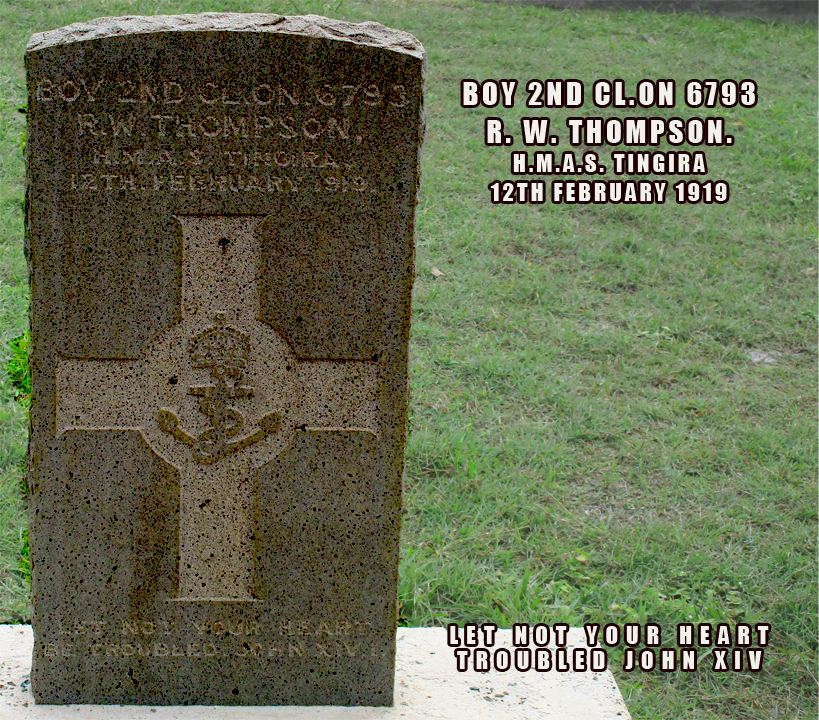
Service record for Reginald Thompson
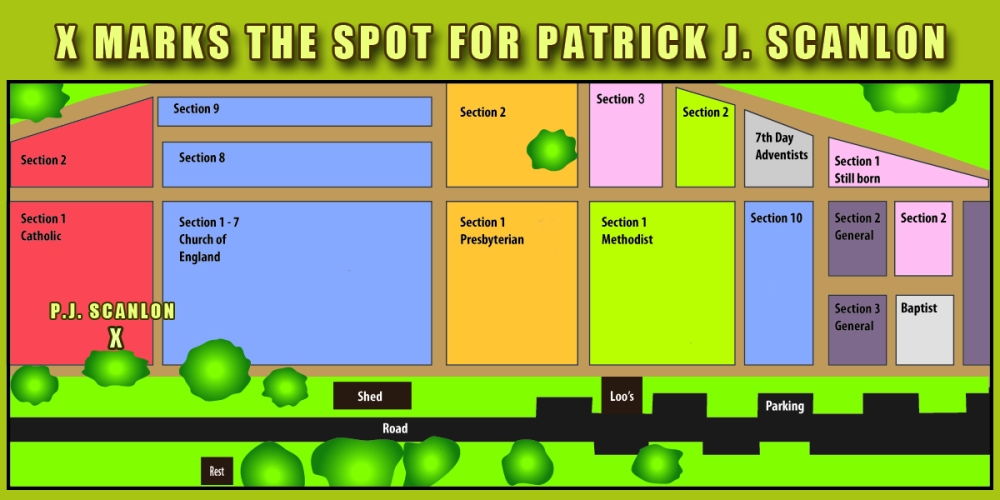
Patrick Joseph Scanlon 20th September, 1924, Aged 40 years
Service number 3682 Brown Trachyte Military Stone
Roman Catholic, Section 1 Row 3 Plot 1
Enlisted in 1917, aged 33 years. Was 5 foot 6inches tall with a fair complexion and auburn/red hair. His record notes his above the knee amputation (right leg) that happened after his term of service. He had been wounded in action, shot in the heel (again right leg) whilst serving. That injury to his heel and any further medical attention required for that heel was under the auspices of Veteran Affairs. Veteran Affairs appear to have paid for the false leg even though the heel injury was no more.
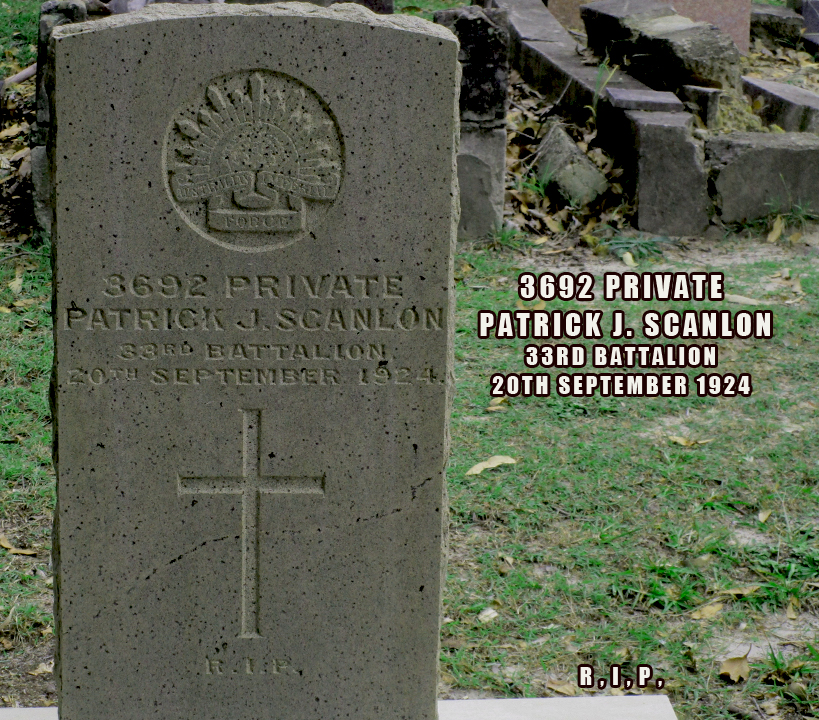
25th September, 1924
P. J SCANLON.
On Saturday morning last, the death, occurred at the residence of his mother, Mrs. McCarthy, Gertrude Street, Gosford, of Mr. Patrick Joseph Scanlon, aged 40. He was a native of Quirindi, but had resided for some time in this district, and enlisted from Gosford for the A.I.F.
He served in the 33rd Battalion, and was wounded at the front in the ankle, and also gassed.
After his return to Australia he was thrown from a train while in charge of some horses returning from Canterbury Races; and a train passing on the next line severed one leg. He was a well-known figure about Gosford of late years, and many friends regret death, and express sympathy with relatives.
Mr. Scanlon (who was generally known as McCarthy, his mother having married a second time) leaves a widow and a son nine years of age. Another son died at the age of five months while Mr. Scanlon was away with the A.I.F. The deceased ex-soldier had been ill for some time, and during –last week became much worse. Medical attention was given, but death came from heart failure. The funeral moved to Point Clare Cemetery on Sunday and was very largely attended.
The Rev. Father Donovan performed the last rites; and a number of wreaths were laid on the casket. Returned soldiers attended in uniform, and six of their number acted as pall-bearers.
25th September, 1924
DEATH.
SCANLON.— September 20th, 1924, at the residence of his mother, Gertrude Street, Gosford, Patrick Joseph Scanlon, aged 40 years.
R.I.P.
Service record for Scanlon
https://recordsearch.naa.gov.au/SearchNRetrieve/Interface/ViewImage.aspx?B=8078490
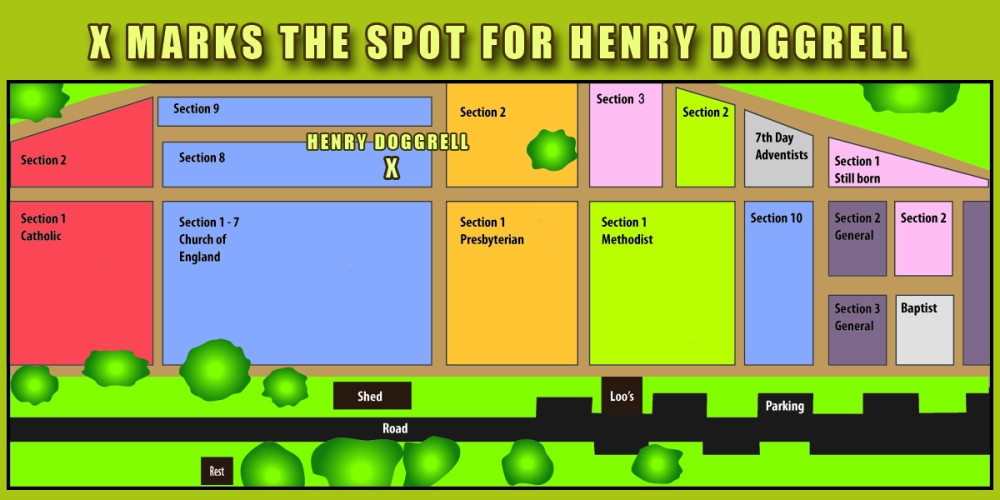
Henry Doggrell 10/11/1949 Aged 60
Service number 4681 White Marble Military Stone
C of E Section 8 Row 7 Plot M3
Henry Doggrell enlisted in July 1915, He was an Englishman born in Dorsett, near the town of Shaftsbury. He was 26 years and 10 months. He had a fresh complexion, blue eyes, and brown hair. He was 5 foot seven inches tall. He was Church of England. He arrived in England by August 1916. He was wounded in action by March 1917 with a gunshot wound to the left leg/thigh. He returned to Australia by April1917. He was Medically Discharged August 1917. Awarded a pension of £3 per fortnight.
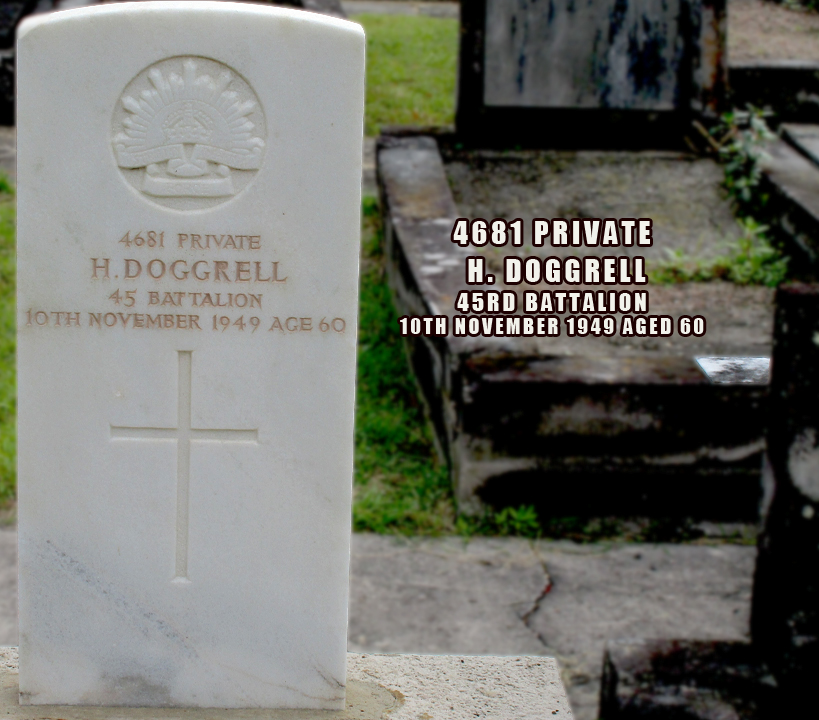
11th November 1949
Man Collapses and Dies In Garden –
Henry Doggrell, 60, collapsed and died in his garden at his home at 75 Hill Street, Gosford, yesterday afternoon about 5 o’clock. Brisbane Water Ambulance officials were told that Doggrell was chipping grass when he collapsed. Doggrell, who was a returned soldier, was a member of the Gosford Buffalo Lodge, of which he was a K.O.M. (Second highest rank)
Mr R. H. Creighton, of Gosford, will conduct the funeral to Point Clare Cemetery today.
The Royal Antediluvian Order of Buffaloes (RAOB) is a fraternal organisation which assists members, their families and charities. It has a tiered structure, with a Grand Lodge, Provincial Grand Lodges and Minor Lodges. Originating in Drury Lane, London, in 1822 when a group of actors set up various lodges as they toured the country, it is now active globally, particularly in former parts of the British Empire. In Sydney the first recorded meetings date from 1882.
45th battalion
Service record for Henry Doggrell
https://recordsearch.naa.gov.au/SearchNRetrieve/Interface/ViewImage.aspx?B=3511460
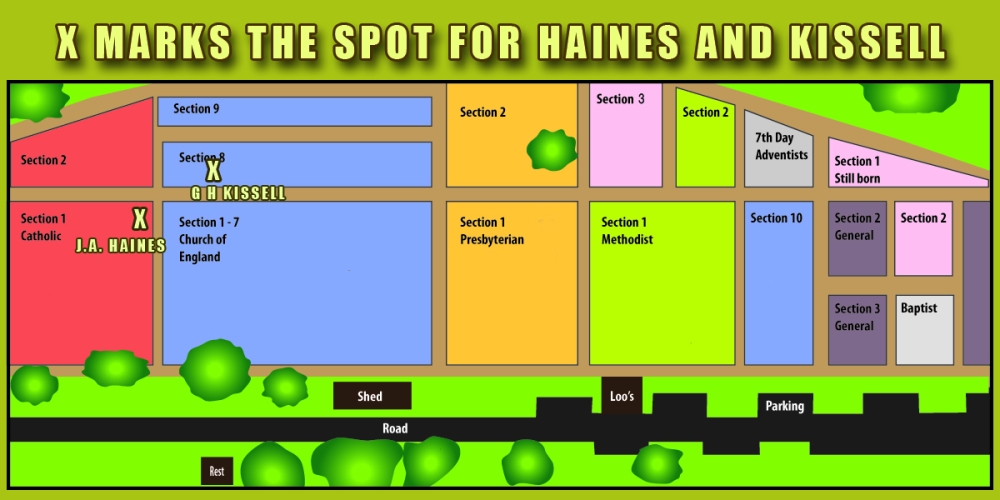
Haines and Kissell
Both Service Number 2624
Both these men are returned servicemen from the First World War. Both of these men survived the ordeals of what the war threw at them. Both of these men received the honour of receiving a beautiful white marble headstone courtesy of the Commonwealth War Graves Commission.
John Albert Haines 27/3/1947 Aged 75
Service number 2624 White Marble Military Stone
C of E Section 5 Row 2 Plot 32
He enlisted in May 1916, aged 44 and 5 months… He was 5 foot 6 inches tall… 13 stone…Dark hair eyes grey with a dark complexion… He embarked August 1916 and served in France for 18 months…He caught the flu which turned into Bronchitis, was unable to train and was a medical discharge 23/12/19 He was a Bootmaker by trade… Ran the Blackwall Post Office he played cricket… was good friends of the Singleton and Buttwell Families… he took Gosford Council to court over the appointment of a staff member without applying the correct procedures… and was the first Secretary of the Woy Woy Branch of the RSL.
There are three mistakes about this stone, one is his age at death… if you do the maths based on his war service record he was 75 not 80 when he died. The cut off age for the Army Service was 45 years, maybe Haines shaved off 5 years when he joined and the family put forward the correct details (?).
The other two mistake are possibly his service number as stated on the stone and that the War graves Commission has it listed as a trachyte stone not white marble.
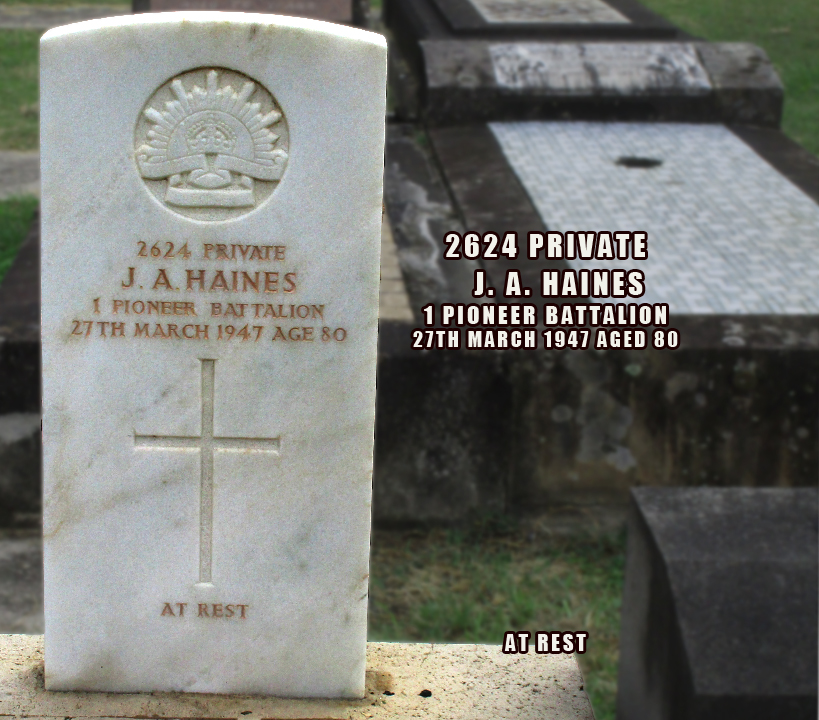
The following article from the local paper is about his son.
13th February 1930
SUCCESSFUL SCHOLAR.
Mr. and Mrs. J. A. Haines, of the Blackwall Post Office, have every reason to feel proud of their son John Haines junior, who is employed at the Standard Weighgoods Works at Clyde, was successful in the fitting and machinery section of the recent technical examinations, and shows good promise of making big strides in the engineering world.
Haines’ War Service Record
http://recordsearch.naa.gov.au/SearchNRetrieve/Interface/ViewImage.aspx?B=4266409
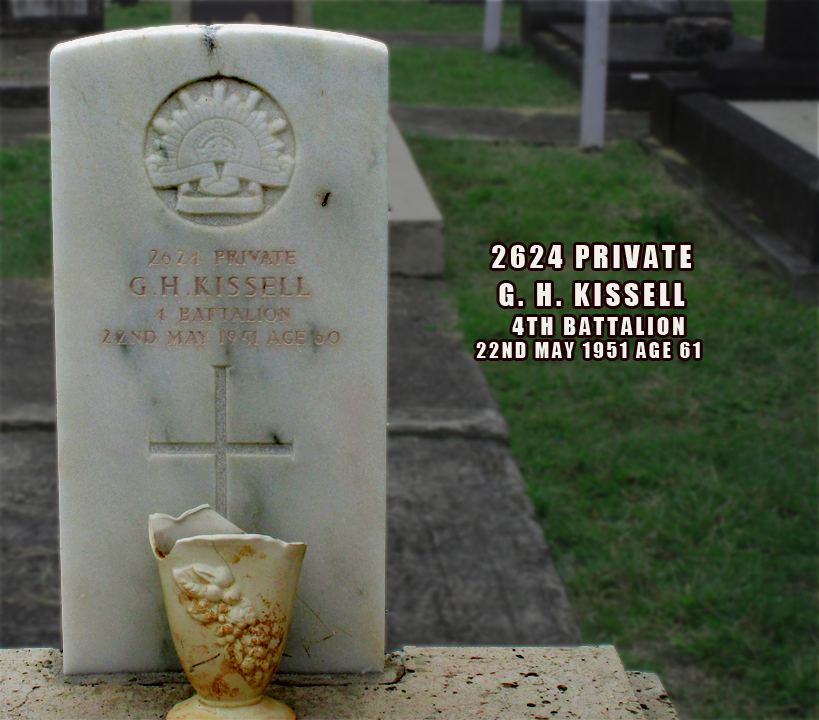
George Henry Kissell 22/5/1951 Aged 60
Service number 2624 White Marble Military Stone
C of E Section 8 Row 12 Plot 18
Enlisted 30 June, 1915… He was living in Bathurst NSW… He was aged 25 years 1 month… He was a labourer. He was 5 foot 4 inches tall… He had a fair complexion, grey eyes and brown hair… He was Church of England He embarked from Australia 9/8/15… He had trouble with his teeth that required medical intervention… He reported to the venereal diseases hospital four times… Was transferred to the cycle Corps and went AWOL four times… was sent to France in January 1916… Sent to London in October 1917 went AWOL again four times… was sent to France in November 1916… wounded in Action January 1917… He went AWOL five times… wounded in Action a second time in October 1917… he kept up his AWOL ways and was finally charged with desertion, he was court marshalled and sentenced to 3 years at Pentonville Prison in Greater London on the 4th November 1918 (one week before the war was declared over 11/11/1918.) he was released from gaol on 21/7/19 and deported to Australia on7/9/19… there is a big stamp on his war service record “Not Eligible For Medals”.
Kisssell’s War Service Record
http://recordsearch.naa.gov.au/SearchNRetrieve/Interface/ViewImage.aspx?B=7373428
This is where these two returned service men have a historical crossing over by having the same identical service numbers. Service numbers are to be allocated to each individual and are generally not supposed to be reused. But during WW1, this pre computer/non centralised data based era, it was common for multiple servicemen to have the same number.
These incidences of multiple men having the same service number happened once someone with the number died during the war, the service number was reissued. Usually they would add a ‘A’ before the number to denote that it was a reissued number however sometimes they did not.

In the case of Haines and Kissell, in this instance, it looks like a mistake of some sort of administrative type. Haines died in 1947 and Kissell in 1950 (or 1951), both servicemen well after the Wars (both of them WW1 and WW2). Also what are the odds of someone being buried within 50 meters of the other out of the 160,000 who enlisted in WW1, with the same service number.
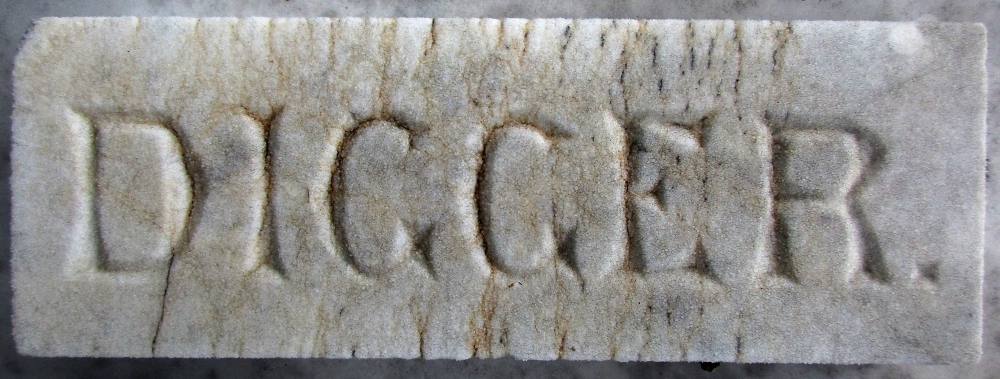
By having a good look at the service records using the links provided Haines has some red pen adding as number 2624 on the front of his file, but my money is on Kissell being the true 2624 although in 1936 on page 7 of Kissell’s record it is noted in handwritten scrawl “No record of 2624 Kissell G. E., 4th Battalion – Is this the man?”. (Note the red pen on Haines records page 5…the service number looks like a later addition) So even at the time of the records being written there was some degree of confusion about these men.
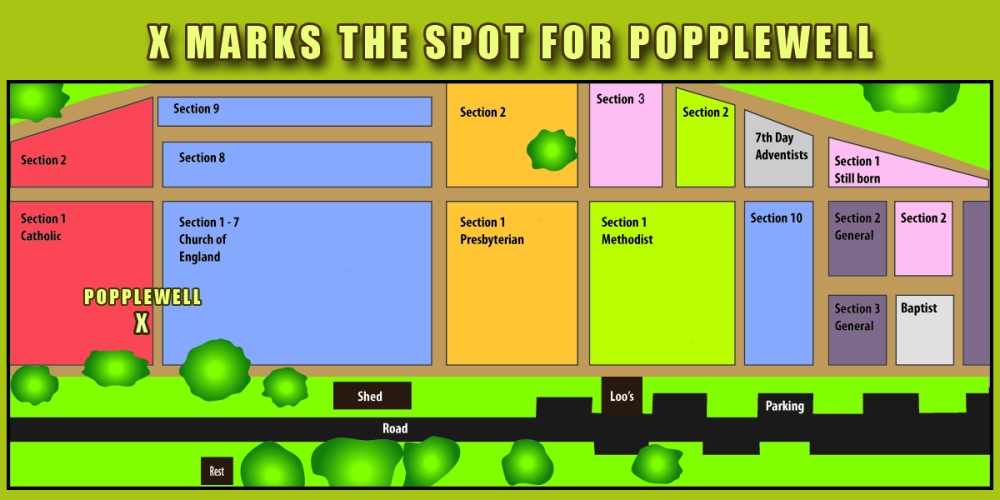
James Lawrence Popplewell 23/11/1941 Aged 63
Service number 5760 Brown Trachyte Military Stone
RC but buried C of E Section 5 Row 1 Plot 18
James Lawrence Popplewell was born in New Zealand and Enlisted February 1916… He was 36 years and five months old and married… a cook and baker by trade… he was Roman Catholic, he has a vaccination scar and it is noted “that he is giving no trouble”. Embarked for Europe in June 1916, was in England with Bronchitis in Dec 1916. He was transferred to France, October 1917 and very quickley wounded in action in October 1917 by a shell wound to the Left shoulder and buttocks and repatriated to England. He was medically discharged in October, 1918.
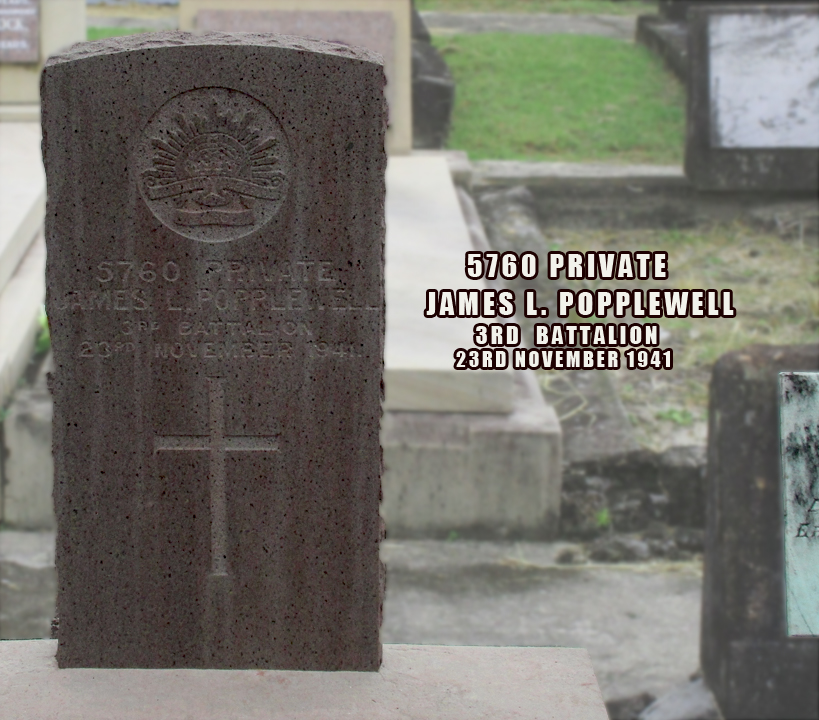
Popplewell’s War Service Record
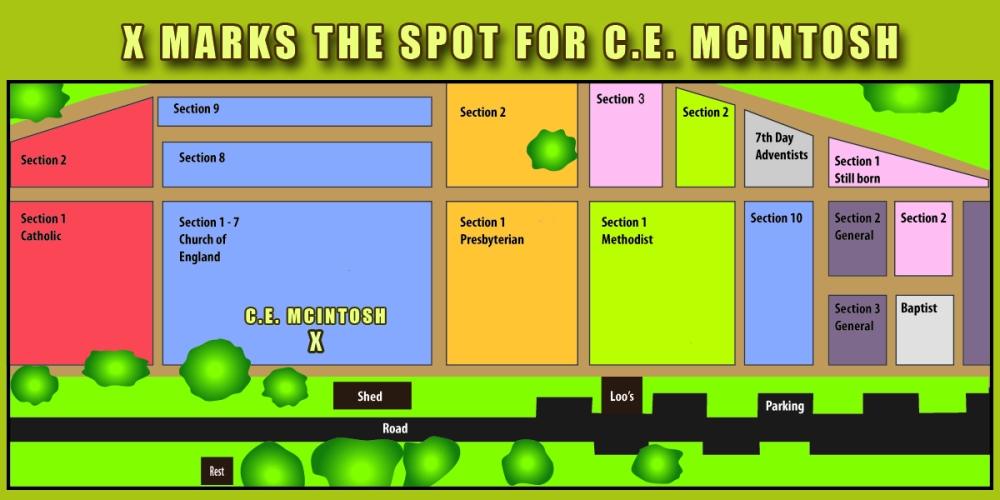
C.E. McIntosh 16/7/1947 Aged 61
Service number 1639 White Marble Military Stone
RC but buried C of E Section 3 Row 3 Plot 75
C. E, McIntosh 29 years and 1 Months of age when he enlisted in June 1915… he was 5 foot 3 inches tall, ruddy complexion with blue eyes and dark brown hair… He had a scar below both knees and a mole between the shoulders… He was a Baker/ Cook by trade… There is a wife noted, but then a further note states that she is dead…Arrived December 1915 ANZAC… sent to VD Hospital in Suez January 1916… in September 1916 Invalided to Australia medically unfit due to VD… In 1957 his son and lost contact with his father and was in Callan Park Mental Institution. The army had to inform the son that his father had died some 5 years earlier.
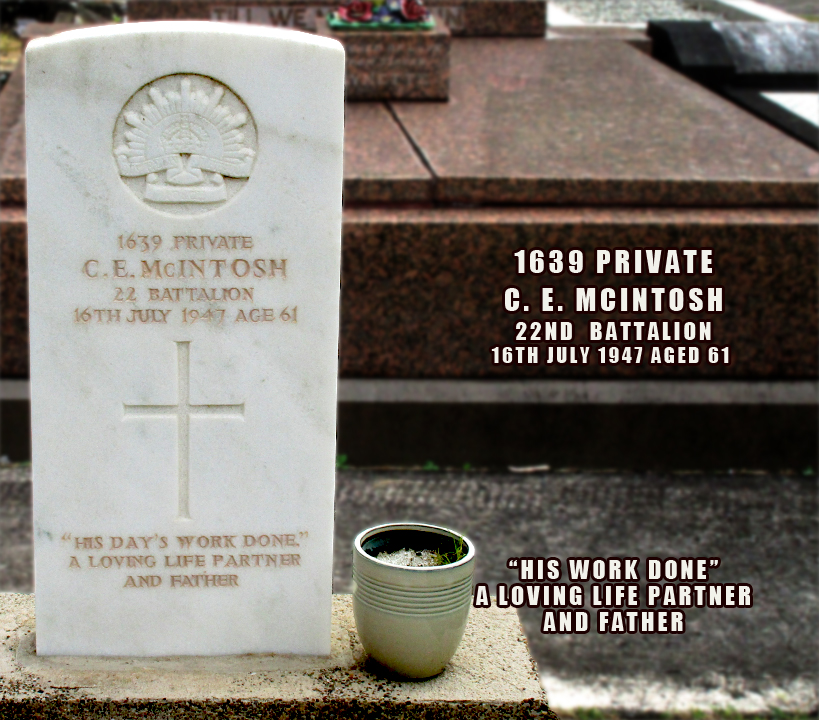
McIntosh’s War Service Record
And just when you think the Commonwealth War Graves Commission has made a further mistake there actually is another McIntosh C. in the graveyard.
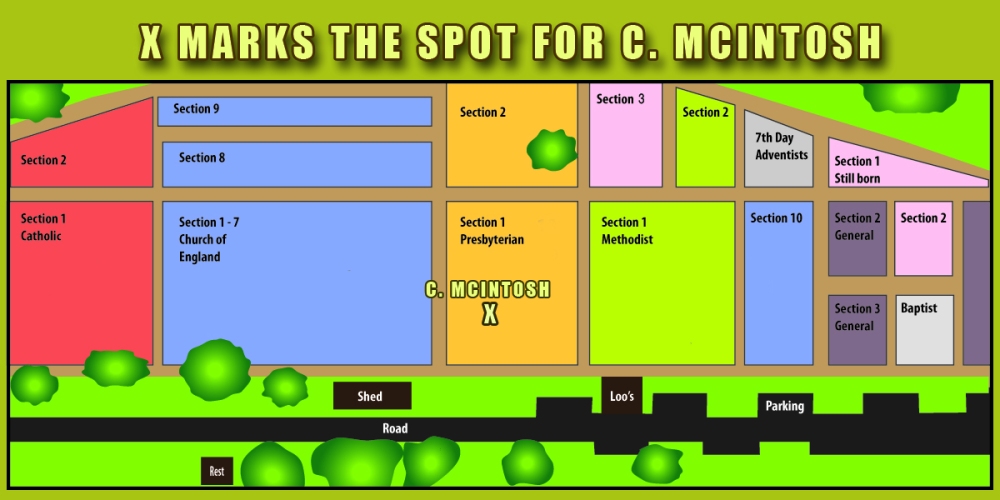
C. McIntosh 16/7/1940 Aged 65
Service number 956 Brown Trachyte Military Stone
Presbyterian Section 1 Row 4 Plot 28
Charles McIntosh enlisted in February 1915 and has a very low service number with only three digits was 39 years and 7 months of age… he puts his trade as Steel Smithing… he had previously seen battle action with the South African Volunteers… he was 5 foot 10 inches tall, dark complexion, dark eyes and dark hair… He was Presbyterian… In September 1917 he had a gunshot wound to the chest… He was discharged in March 1918… In 1940 there seemed to be a hitch with his estate. There is a letter requesting the locations of the witness’s to his Will, that he wrote whilst in the Army. The Army had to write back to inform them that both of the witness’s to his Will had been killed in Action.
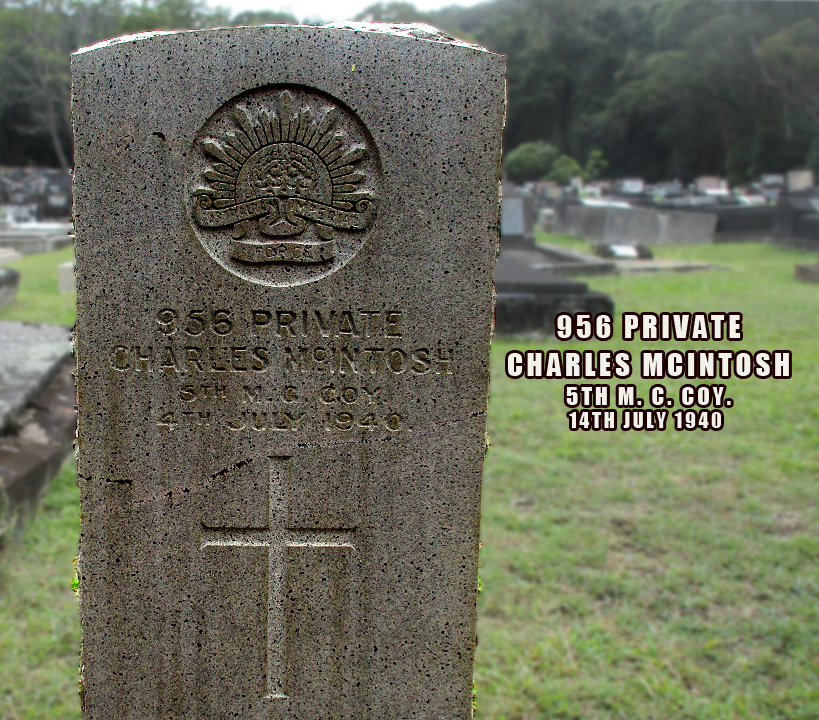
C.McIntosh’s War Service Record
https://recordsearch.naa.gov.au/SearchNRetrieve/Interface/ViewImage.aspx?B=1946361
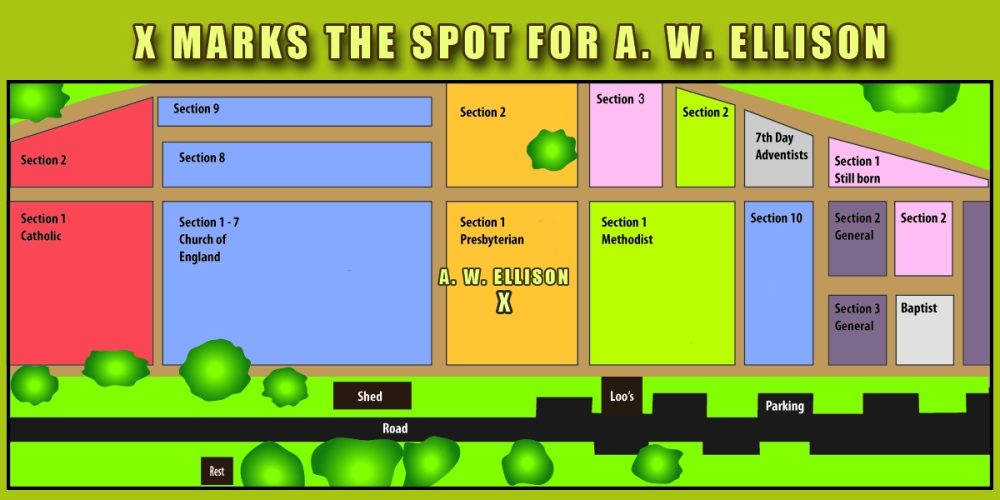
Alexander William Ellison 28/6/1943 Aged 64
Service number 252 White Marble Military Stone
Church of England Section 5 Row 3 Plot 72
Alexander William Ellison enlisted just one month after the beginning of World War 1 in August 1914, hence is extra low, three figured service number.
He was born in Adelaide and was 36 years 3 months of age… He was 5 foot 5inches tall with brown hair brown eyes… He was a horse Groom… He was a Trooper with the 6th Light Horse He was Church of England… Enlisted august 1914… Went to Malta… Caught Dysentery at Gallipoli… August 1915… December 1915… Medically discharged June 1916 Suffering from nervousness, very weak, loss of flesh, diarrhoea and recommended for further treatment. 2 months convalesce. He was married to Agnes Ellison who applied for a Widow’s badge in March 1945 to be told that they did not make them anymore.
Commonwealth War Graves commission has this stone in their records as a trachyte granite stone.
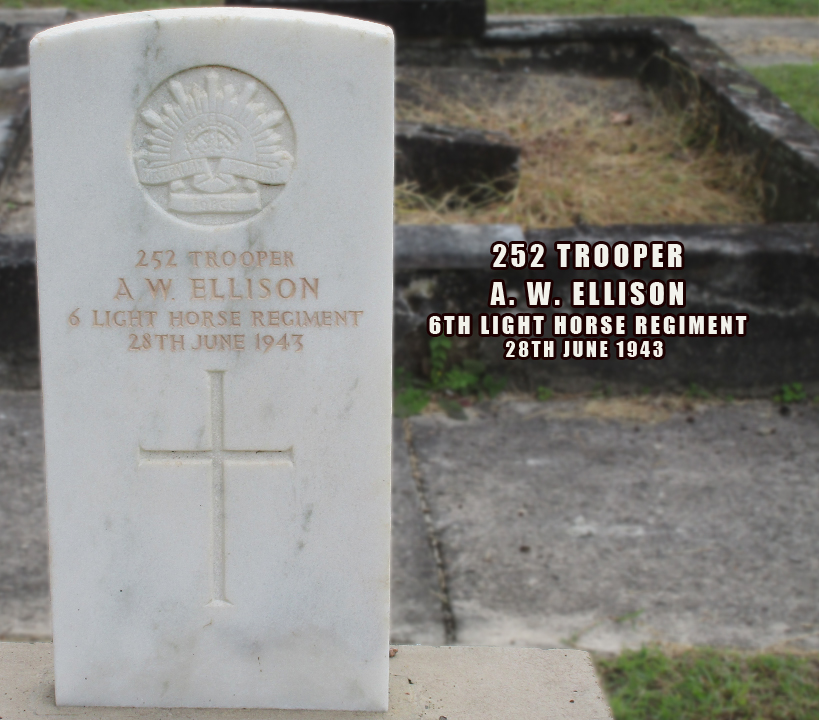
Ellison’s War Service Record
12th July 1917
THE ANZACS’ DICTIONARY.
Language of the Trenches.
The following is a list of words or phrases used in the trenches in Flanders :—
Aussie ( “Ozzy”): An Australian soldier.
Tommy or Choom : An English soldier.
Jock : A Scotch soldier.
Zealand : A New Zealand soldier. (Call him Pig Island if you would make him wild.)
Fritz : A German soldier.
Savee : Do you know.
Compree : Do you understand.
Imshi : Clear out.
Backshee : Something for nothing.
Chatty : Affected with trench vermin, known as chats.
Clink : Gaol
Bird : Prisoner.
Quack : The army doctor.
Swinging the Lead : Evading service ; malingering.
The Heads : Those in authority.
Dead Meat Tickets : Identification
Tray Bong : Very good.
Hickory : Be off.
Barometer Gas helmet.
Tin Hat : Steel helmet.
Shooting Stick : Rifle.
Ham and Chicken : Ammunition.
Mills’ Pills : Mills’ hand grenades.
No. 9 : Pills ordered by the army doctor.
Freak Villa : The cook-house.
Babbling Brook : The cook.
Iodine Villa : Where the doctor rests his patients.
Army Nervous Corps : Service Corps. ,3V
Dinkum Oil : Straight information.
Napooh Mafeesh : The finish.
Dopey : Silly.
One-star Artist : A second lieutenant.
Tanks or Oases : Army boots.
Mad Mick and Banjo: Pick and shovel.
Knocked : Wounded.
Skittled : Killed.
To get a Blighty : To be wounded and sent back to England.
Home and Dried : Safe and sound.
Hop Over To go over the trenches towards the enemy.
Iron Rations for Fritz : Shells for the enemy
Comfort Funds Shells.
Fags : Cigarette.
Step the Gutter : Pass the butter.
Jack Scratch Got a match
Wandering Jew : Stew.
Dodger : Bread.
Possie : Position.
Digger : A West Australian.
Jack, Charlie, Mac. : A handy name for anyone.
Dag : A character, a ‘ hard case.
Windbag : A talker out of his turn.